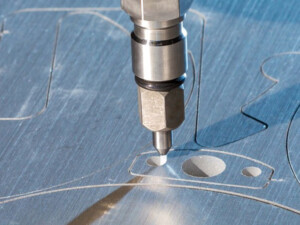
How Accurate Waterjet Cutting Services Elevate Your Manufacturing Projects
In the world of modern manufacturing and fabrication, precision is not just a desirable attribute—it’s an absolute necessity. Whether you’re crafting intricate aerospace components, detailed architectural elements, or custom automotive parts, the margin for error is increasingly slim. This is where accurate waterjet cutting services come into play, offering a level of precision and versatility that is hard to match with other cutting technologies. But what exactly makes this service so reliable, and what should you know before engaging a provider? This article delves deep into the mechanics, benefits, and practical considerations of using accurate waterjet cutting services for your projects.
What Makes Waterjet Cutting So Accurate?
At its core, waterjet cutting is a process that uses a high-pressure stream of water—often mixed with an abrasive substance like garnet—to cut through materials. The key to its accuracy lies in its computerized numerical control (CNC) system. This computer-guided technology ensures that the waterjet follows a pre-programmed design path with exceptional precision, often achieving tolerances as tight as ±0.001 inches (±0.025 mm). Unlike thermal cutting methods like laser or plasma, which can generate heat and cause material distortion, waterjet cutting is a cold process. This means the structural integrity of the material remains unchanged, eliminating the risk of heat-affected zones (HAZ) that can compromise accuracy. The combination of advanced CNC software, high-pressure pumps (reaching up to 90,000 psi), and specialized abrasive feed systems allows accurate waterjet cutting services to produce complex geometries and fine details consistently.
The Unmatched Versatility of Materials
One of the most significant advantages of opting for accurate waterjet cutting services is their remarkable ability to handle a vast array of materials. From the hardest metals to the most delicate composites, waterjets do not discriminate.
Metals: Steel, stainless steel, aluminum, titanium, brass, and copper can all be cut with precision without altering their metallurgical properties.
Stone and Tile: Granite, marble, and ceramic tiles are cut smoothly without chipping or cracking.
Glass: Both thick and thin glass can be cut intricately without causing fractures.
Composites and Laminates: Materials like carbon fiber, fiberglass, and Kevlar, which are prone to delamination with other methods, are cleanly sliced.
Plastics and Rubber: Acrylic, polycarbonate, and rubber are cut without melting or emitting toxic fumes.
This versatility means you can rely on a single accurate waterjet cutting service for multiple projects across different industries, streamlining your supply chain and ensuring consistency in quality.
Complex Geometries and Intricate Designs Made Simple
When your project demands complex shapes, sharp corners, or intricate patterns, accurate waterjet cutting services are often the best solution. The cutting stream, which is typically only 0.02 to 0.05 inches in diameter, acts like a precision tool that can maneuver through detailed designs without the need for tool changes. This capability is particularly valuable for prototyping, custom art installations, and engineering components that require exact specifications. The software used allows for nesting parts efficiently on a single sheet of material, minimizing waste and reducing costs. Whether you need to produce a single prototype or a large production run, the repeatability of the process ensures every piece is identical to the last.
Environmental and Safety Advantages
In an era where sustainable manufacturing practices are increasingly important, accurate waterjet cutting services offer several environmental and safety benefits. The process primarily uses water and natural abrasives, which are non-toxic and recyclable. Unlike laser or plasma cutting, it does not produce hazardous fumes or vapors, making it safer for operators and better for the environment. Additionally, because it generates no heat, it reduces the risk of fire hazards in the workshop. The waste produced—a mixture of water and abrasive material—can often be separated and reused or disposed of with minimal ecological impact. This makes accurate waterjet cutting services a responsible choice for companies aiming to reduce their carbon footprint.
Cost-Effectiveness and Efficiency
While the initial investment in waterjet technology can be high, the cost-effectiveness of using accurate waterjet cutting services is evident in several ways. First, the ability to cut virtually any material eliminates the need for multiple specialized machines, saving on capital equipment costs. Second, the minimal setup time required for each job allows for quick turnaround times, which is crucial for meeting tight deadlines. The reduction in material waste due to efficient nesting software directly lowers material costs. Moreover, because no secondary finishing processes (like deburring or smoothing heat-affected edges) are typically needed, you save both time and labor costs. For low-volume production runs and custom one-off pieces, this efficiency makes accurate waterjet cutting services an economically smart choice.
Common Questions About Accurate Waterjet Cutting Services
1. How thick of a material can a waterjet cut?
Waterjets are capable of cutting materials over 12 inches thick, depending on the hardness of the material. Softer materials like foam and rubber can be cut even thicker, while harder metals like titanium might be limited to thinner sheets for optimal precision.
2. What is the typical tolerance achievable?
Most accurate waterjet cutting services can hold tolerances between ±0.001 inches to ±0.005 inches. The exact tolerance depends on factors like material type, thickness, and the specific equipment used.
3. Is waterjet cutting suitable for food-grade materials?
Yes. Pure waterjet cutting (without abrasives) is often used in the food industry to cut products like candy, frozen foods, and pastries. It is a clean and sterile process.
4. How does waterjet cutting compare to laser cutting in terms of accuracy?
Both can achieve high accuracy, but laser cutting may struggle with reflective materials (like copper or aluminum) and can heat the material. Waterjet is a cold process and handles reflective materials with ease, though laser might be faster on thin sheets of metal.
5. Can waterjet cutting create internal threads or tapped holes?
While waterjets can cut precise holes, they do not create threads. The holes can be cut to the exact size required for subsequent tapping operations.
6. How long does it take to cut a part?
Cutting speed varies greatly based on material type and thickness. For example, cutting through 1-inch thick steel will be significantly slower than cutting through 1-inch thick foam. A service provider can give you an estimated time based on your specific design.
Accurate waterjet cutting services represent a fusion of precision, versatility, and efficiency that is transforming manufacturing and design across industries. By understanding the technology’s capabilities—from its cold-cutting process that preserves material integrity to its ability to handle an enormous range of materials with intricate detail—you can make an informed decision that enhances your project’s quality and viability. Whether you’re an engineer, designer, or fabricator, leveraging this technology can be the key to achieving unparalleled accuracy and innovation in your work.
When considering a provider, always look for one with a proven track record, advanced CNC technology, and a commitment to quality control to ensure you receive the most accurate waterjet cutting services available.
continue reading
Related Posts
- 1371 words6.9 min read
- 1449 words7.3 min read


